MLCC - multilayer chip ceramic capacitors, or chip capacitors for short, can cause noise whistle...
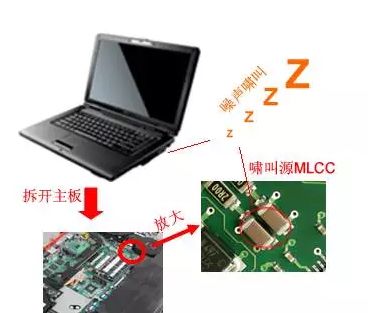
Example of howling circuit of laptop power circuit
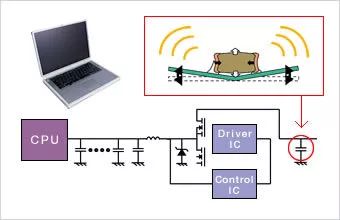
As people's demand for electronic equipment has tended to be calm, in the power supply circuits of various applications such as notebook computers, mobile phones, and digital still cameras (DSCs), the “howling†problem caused by the vibration of capacitors that has not been taken seriously before has become a problem. Become a design topic.
The sound is derived from the vibration of an object. Sound waves with a frequency of 20 Hz to 20 kHz can be recognized by the human ear.
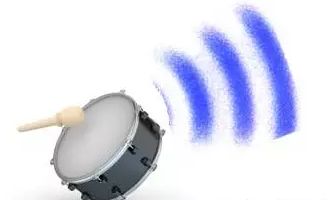
The MLCC emits a howling sound, which means that the MLCC undergoes a relatively large vibration (microscopically larger, less than 1 nm) under the influence of voltage.
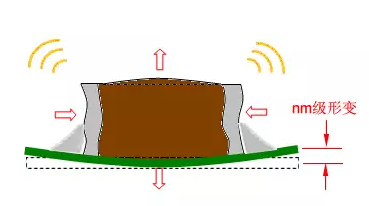
Why does MLCC vibrate? We must first understand a natural phenomenon - electrostriction. Under the action of an external electric field, all materials will produce a telescopic deformation - electrostriction. For some ferroelectric materials with high dielectric constants, the electrostrictive effect is intense, called the piezoelectric effect. Piezoelectric effects include positive piezoelectric effects and inverse piezoelectric effects
Summary: howling
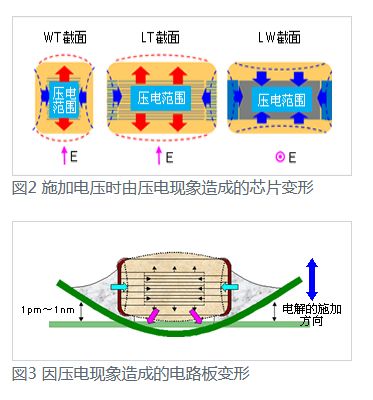
Because of the piezoelectric characteristics of a ceramic with a strong dielectric constant, the monolithic chip capacitors shrink as shown in FIG. 2 when an AC voltage is applied.
As a result, as shown in Figure 3, the circuit board will vibrate in the plane direction. (The amplitude of the chip and circuit board is only about 1pm to 1nm)
When the amplitude period of this circuit board reaches the frequency band (20 Hz to 20 kHz) that people can hear, the sound can be recognized by the human ear.
The positive piezoelectric effect exerts mechanical pressure on dielectric materials with piezoelectric properties. The dielectric crystals undergo structural reorganization, and charges are induced on the surface of the material to generate a potential difference.
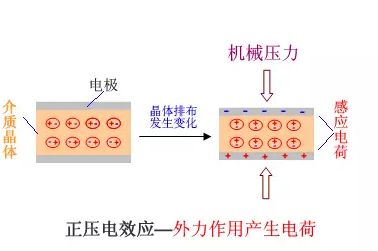
Converse Piezoelectric Effect When a voltage is applied to a dielectric material having piezoelectric properties, mechanical stress occurs and distortion occurs.
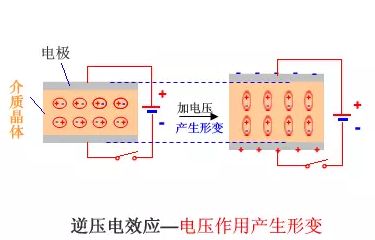
The academic definition of the piezoelectric effect: "When pressure, tension, and tangential forces are applied to a crystal without a symmetrical center, a dielectric polarization proportional to the stress occurs, and positive and negative charges appear at both ends of the crystal. Phenomenon is called positive piezoelectric effect, on the other hand, if an electric field is applied to the crystal to cause polarization, then deformation or mechanical stress proportional to the electric field strength is generated, and this phenomenon is called converse piezoelectric effect. The effect is collectively called the piezoelectric effect."
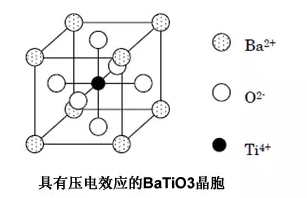
Ceramic media is the main component of MLCC. Under the action of voltage, electrostriction is inevitable. If the electrostriction strongly manifests itself as a piezoelectric effect, vibration is generated.
Will all MLCCs scream? MLCC design and manufacture of ceramic dielectric materials are mainly paraelectric and ferroelectric medium two major categories.
Paraelectric dielectric, also known as Class I medium, mainly SrZrO3, MgTiO3 and so on. Paraelectric dielectric electrostriction deformation is very small, under the operating voltage, not enough to generate noise. Therefore, MLCCs made of paraelectric (type I) materials, such as NPO (COG) and other temperature-stable products, will not produce noise whistle.
Ferroelectric medium, also known as Class II medium, mainly BaTiO3, BaSrTiO3 and so on. Ferroelectrics have strong electrostrictive properties—piezoelectric effects. Therefore, MLCCs made of ferroelectric dielectrics (Class II dielectrics), such as X7R/X5R, produce significant noise squeaking under the influence of large AC field strength.
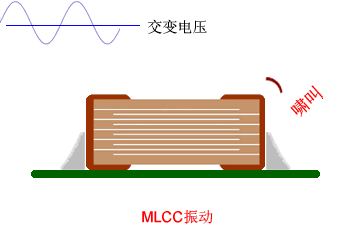
As shown above, after a large voltage change is applied to both ends of the X7R-MLCC, the BaTiO3 ceramic generates an inverse piezoelectric effect, and the MLCC deformation vibrates and transmits to the PCB to cause resonance.
When the frequency of the voltage signal is within 20 Hz to 20 kHz of human hearing, the capacitor can be heard whistling.
What occasions MLCC whine obvious? Larger alternating voltage, frequency between 20Hz and 20kHz, using X7R/X5R class high capacity MLCC, will produce a clear whistle, such as switching power supply, high frequency power and other occasions.
The danger of howling many mobile electronic devices close to the human ear, such as: laptops, tablet computers, smart phones, etc., such as electronic circuits have audible noise will affect the use of feelings. In addition to being annoying, there may be hidden dangers of inadequate reliability design. Severe screaming results from severe vibrations, and the amplitude of vibration is determined by the degree of piezoelectricity. The piezoelectric effect is proportional to the electric field strength, the applied voltage is constant, the thinner the medium, the stronger the piezoelectric effect, and the louder the howling sound.
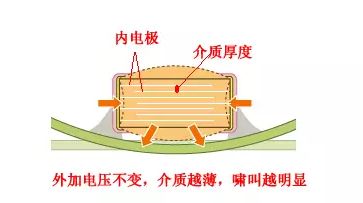
The rated voltage is determined by the material and dielectric thickness of the MLCC. Severe whistling indicates that the MLCC medium chosen for the current operating voltage is too thin, and a thicker, higher rated voltage MLCC should be considered.
For ferroelectric ceramics, under the action of an alternating electric field, there are also problems in which ferroelectric domains alternately turn to internal friction. The alternating field is strong, internal friction is serious, and the chance of failure increases. This can be reflected in the size of the howling sound.

Solutions to howling can be reduced There are many ways to reduce the audible noise produced by MLCC capacitors, and all solutions increase costs. 1. It is the most direct method to change the type of capacitor. It is replaced by a non-piezoelectric effect capacitor such as paraelectric ceramic capacitor, tantalum capacitor and film capacitor. But you need to consider issues such as volume, reliability, and cost. 2. Adjust the circuit to eliminate the large alternating voltage added to the MLCC or shift its frequency out of the human ear to sense the frequency band (the ear most sensitive to audio is 1KHz~3KHz). 3, pay attention to PCB layout, PCB board specifications, help reduce the howling level. 4. Use noiseless or low noise MLCC.
Design of Noise-Free/Low-Noise MLCCs Currently there are three types of solutions to address the whistle of MLCCs.
(1) Thickening the bottom protective layer Because the thickness of the protective layer has no internal electrode, this part of the BaTiO3 ceramic does not deform. When the height of the solder at both ends does not exceed the thickness of the bottom protective layer, the resulting deformation will affect the PCB. Small, effective in reducing noise.
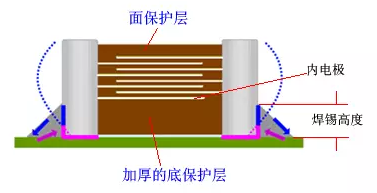
(2) The structure of the additional metal support structure is shown below. It uses a metal support to vacate the MLCC chip.
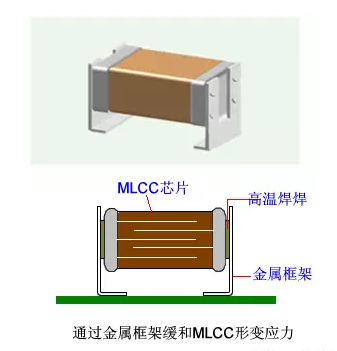
The MLCC and the PCB board are separated from each other, and the deformation caused by the inverse piezoelectric effect is elastically buffered by the metal bracket, thereby reducing the effect on the PCB board and effectively reducing the noise.
(3) Designing and fabricating using dielectric material with weak piezoelectric effect Sacrificial materials of dielectric properties and temperature characteristics are sacrificed by further doping of barium titanate (BaTiO3) to obtain a dielectric material with greatly reduced piezoelectric effect. Effectively reduce noise. Major MLCC manufacturers have their own MLCC product line with low noise.
With the improvement of people's quality of life, people's lifestyles have also become varied. Different kinds of recreational products are starting to appear in people's lives, such as electronic cigarettes. The emergence of e-cigarettes represents a part of young people's thinking and means that electronic products are beginning to show a trend towards diversity.
simply replace the pods. The Pod system uses an integrated pod rather than a tank for higher nicotine strength and provides low power traction. the Pod system is rechargeable and has a longer life and higher battery capacity than disposable electronic cigarettes.
Our company Pod system has a built-in 380mAh battery and a USB charging port on the bottom. In comparison, the Pod system has a built-in battery of only 180mAh, but the Pod system charges much faster.
Our electronic cigarettes are of rechargeable construction. The first time you use the charger to charge, it is recommended to use up the remaining power before filling up, this is to ensure the performance of the battery.
Vape Pod System Oem,Vape Pod Oem,Close Pod Oem,Thc Pod Disposable
Shenzhen MASON VAP Technology Co., Ltd. , https://www.disposablevapepenfactory.com
